It’s not time for battle, it’s time for balance!
In 2023, the unforgiving state of the business world has HR professionals ready to fight for their organizations and teams, but there’s a better way forward. To keep steady in our fast-paced, tech-focused world, balance is key.
But how can a company find balance to thrive amidst economic turbulence and rapidly evolving technology? How does an organization innovate to stay competitive?
The answer lies in taking a step back, regaining focus, and building new processes that promote balance and sustainability for both employees and companies. Those who refuse to acknowledge this need for balance risk hitting a proverbial brick wall.
This blog will explore three practical ways that HR leaders and professionals can help create a system of balance, ensuring long-term success for both employees and organizations.
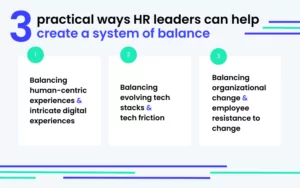
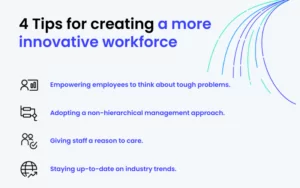 Innovation in the workplace allows for new ideas, services, products, business processes, or methodologies to be introduced in a work environment. There are several techniques that employers can use to encourage innovation in the workplace, such as:
Innovation in the workplace allows for new ideas, services, products, business processes, or methodologies to be introduced in a work environment. There are several techniques that employers can use to encourage innovation in the workplace, such as:
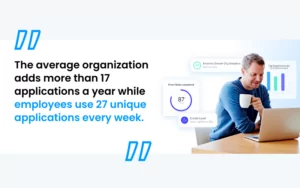 However, it’s important to consider the potential challenges that can arise from introducing new technology into a business. The average organization adds more than 17 applications a year while employees use 27 unique applications every week.
This rapid growth creates challenges, such as compatibility issues, the need for employee training, and overall resistance to change. These challenges can lead to digital friction, hindering the adoption and effectiveness of new technology, which may be critical for businesses in this uncertain economic landscape.
To balance these competing interests, businesses can utilize a DAP alongside other HR tech applications to assess the ROI of new and existing technology. By analyzing data across all applications, DAPs can provide insights into the potential benefits and new opportunities for your software, while identifying and mitigating friction points.
Balancing the advancement of tech and simplified adoption processes to avoid digital friction is critical for businesses looking to stay ahead of the competition while avoiding potential pitfalls. Utilizing data analytics platforms to assess the ROI of new technology and mitigate potential challenges, businesses can make informed decisions about which technology to adopt and ensure that they are maximizing their ROI.
However, it’s important to consider the potential challenges that can arise from introducing new technology into a business. The average organization adds more than 17 applications a year while employees use 27 unique applications every week.
This rapid growth creates challenges, such as compatibility issues, the need for employee training, and overall resistance to change. These challenges can lead to digital friction, hindering the adoption and effectiveness of new technology, which may be critical for businesses in this uncertain economic landscape.
To balance these competing interests, businesses can utilize a DAP alongside other HR tech applications to assess the ROI of new and existing technology. By analyzing data across all applications, DAPs can provide insights into the potential benefits and new opportunities for your software, while identifying and mitigating friction points.
Balancing the advancement of tech and simplified adoption processes to avoid digital friction is critical for businesses looking to stay ahead of the competition while avoiding potential pitfalls. Utilizing data analytics platforms to assess the ROI of new technology and mitigate potential challenges, businesses can make informed decisions about which technology to adopt and ensure that they are maximizing their ROI.
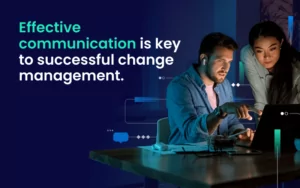 To effectively balance organizational change and employee resistance, it’s important to establish a culture of transparency and open communication. To achieve this, it’s essential to implement a change management strategy that actively involves employees in the change process.
This includes explaining the reasoning behind the change and how it will affect both the organization and individuals, as well as actively listening to and addressing any employee concerns that arise. Companies can then facilitate a smoother transition to new systems or processes while ensuring that employees feel valued and respected throughout the change process.
To effectively balance organizational change and employee resistance, it’s important to establish a culture of transparency and open communication. To achieve this, it’s essential to implement a change management strategy that actively involves employees in the change process.
This includes explaining the reasoning behind the change and how it will affect both the organization and individuals, as well as actively listening to and addressing any employee concerns that arise. Companies can then facilitate a smoother transition to new systems or processes while ensuring that employees feel valued and respected throughout the change process.
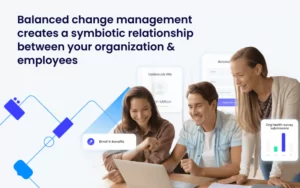 Investing in a balanced change management strategy creates a symbiotic relationship between your organization and employees, where they both benefit from the commitment to one another.
Investing in a balanced change management strategy creates a symbiotic relationship between your organization and employees, where they both benefit from the commitment to one another.

Balancing human-centric experiences and intricate digital experiences
The importance of people analytics cannot be overstated. With the ever-increasing complexity of workflows and processes, it is essential for companies to use data-driven insights to tackle these challenges. In particular, the HR side of things, including employee struggles with digital processes, can benefit greatly from the use of people analytics. By using data-driven insights, companies can identify areas where employees are struggling with digital processes and workflows. This information can then be used to build customizable workflows that merge organizational processes with human interactions to build simpler and more efficient systems. One way to accomplish this is through the use of digital adoption platforms (DAPs) like WalkMe. DAPs analyze and track user experience, providing valuable insights into how employees are interacting with digital tools and processes. By using this information, companies can identify digital friction points and develop customized workflows that address these issues to prioritize human outcomes. Human outcomes require human input, which means new ideas for experimentation. Companies that partner with their workforce and experiment with what’s possible create sustainable models of work, making work better for humans and humans better at work.How to build a culture of innovation in the workplace
Workplace innovation is an evidence-based practice that enables employees at every level to use and develop their skills, which can help leverage worker motivation and co-creation to drive mutual and elevated benefits. Innovation in the workplace allows for new ideas, services, products, business processes, or methodologies to be introduced in a work environment. There are several techniques that employers can use to encourage innovation in the workplace, such as:
Innovation in the workplace allows for new ideas, services, products, business processes, or methodologies to be introduced in a work environment. There are several techniques that employers can use to encourage innovation in the workplace, such as:
- Empowering employees to think about tough problems.
- Adopting a non-hierarchical management approach.
- Giving staff a reason to care.
- Staying up-to-date on industry trends.
Balancing evolving tech stacks and tech friction
On one hand, investing in new technology can be crucial for businesses to remain competitive and keep up with the latest trends and volatile markets within their industry. For example, adopting new software or hardware can create unique selling propositions, which leads to improved efficiency, better employee and customer experiences, and increased revenue. However, it’s important to consider the potential challenges that can arise from introducing new technology into a business. The average organization adds more than 17 applications a year while employees use 27 unique applications every week.
This rapid growth creates challenges, such as compatibility issues, the need for employee training, and overall resistance to change. These challenges can lead to digital friction, hindering the adoption and effectiveness of new technology, which may be critical for businesses in this uncertain economic landscape.
To balance these competing interests, businesses can utilize a DAP alongside other HR tech applications to assess the ROI of new and existing technology. By analyzing data across all applications, DAPs can provide insights into the potential benefits and new opportunities for your software, while identifying and mitigating friction points.
Balancing the advancement of tech and simplified adoption processes to avoid digital friction is critical for businesses looking to stay ahead of the competition while avoiding potential pitfalls. Utilizing data analytics platforms to assess the ROI of new technology and mitigate potential challenges, businesses can make informed decisions about which technology to adopt and ensure that they are maximizing their ROI.
However, it’s important to consider the potential challenges that can arise from introducing new technology into a business. The average organization adds more than 17 applications a year while employees use 27 unique applications every week.
This rapid growth creates challenges, such as compatibility issues, the need for employee training, and overall resistance to change. These challenges can lead to digital friction, hindering the adoption and effectiveness of new technology, which may be critical for businesses in this uncertain economic landscape.
To balance these competing interests, businesses can utilize a DAP alongside other HR tech applications to assess the ROI of new and existing technology. By analyzing data across all applications, DAPs can provide insights into the potential benefits and new opportunities for your software, while identifying and mitigating friction points.
Balancing the advancement of tech and simplified adoption processes to avoid digital friction is critical for businesses looking to stay ahead of the competition while avoiding potential pitfalls. Utilizing data analytics platforms to assess the ROI of new technology and mitigate potential challenges, businesses can make informed decisions about which technology to adopt and ensure that they are maximizing their ROI.
Balancing organizational change and employee resistance to change
Organizational change is an inevitable reality that can be driven by market volatility, technology advancements, and consumer preferences, or internal factors such as mergers and acquisitions. While change can increase efficiency and market share, it can also cause disruption and stress for employees. Resistance to change often stems from fear of job loss, increased workload, uncertainty about new roles, or a lack of trust in management. This resistance can cause decreased productivity, absenteeism, or even active sabotage. Change can also temporarily decrease productivity and cause employee frustration by requiring new processes or technology. Effective communication is crucial during change to avoid employee disengagement or resistance, which can make successful implementation even more challenging. To effectively balance organizational change and employee resistance, it’s important to establish a culture of transparency and open communication. To achieve this, it’s essential to implement a change management strategy that actively involves employees in the change process.
This includes explaining the reasoning behind the change and how it will affect both the organization and individuals, as well as actively listening to and addressing any employee concerns that arise. Companies can then facilitate a smoother transition to new systems or processes while ensuring that employees feel valued and respected throughout the change process.
To effectively balance organizational change and employee resistance, it’s important to establish a culture of transparency and open communication. To achieve this, it’s essential to implement a change management strategy that actively involves employees in the change process.
This includes explaining the reasoning behind the change and how it will affect both the organization and individuals, as well as actively listening to and addressing any employee concerns that arise. Companies can then facilitate a smoother transition to new systems or processes while ensuring that employees feel valued and respected throughout the change process.
How to simplify workflows and prioritize employee development
It’s essential to simplify workflows and create more human-centered processes. This means streamlining processes to make work more manageable and less stressful for employees. By simplifying workflows, employees can focus on their core tasks, be more productive, and feel less overwhelmed. Additionally, providing training and development opportunities can help employees adapt to change and acquire new skills that make them more valuable to the organization. By investing in employee development, organizations can demonstrate their commitment to their employees’ growth and well-being. Balancing organizational change and resistant employees requires a thoughtful, human-centered approach that prioritizes transparency, simplification, and employee development. A DAP can help create a culture of open communication using systems for open feedback via platform, in-app guidance, and customized employee training. In addition, DAP enables you to recognize employees’ efforts by measuring efficiency output, allowing you to successfully navigate change while minimizing burnout and churn. Investing in a balanced change management strategy creates a symbiotic relationship between your organization and employees, where they both benefit from the commitment to one another.
Investing in a balanced change management strategy creates a symbiotic relationship between your organization and employees, where they both benefit from the commitment to one another.

